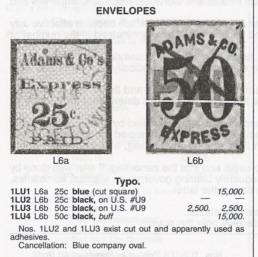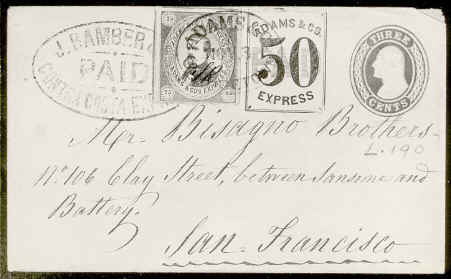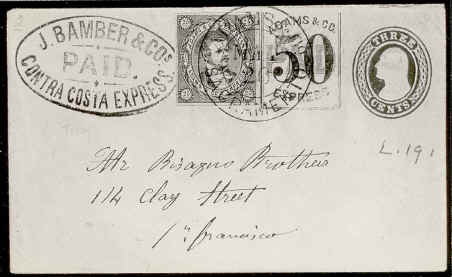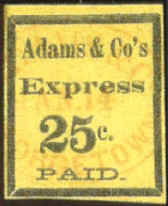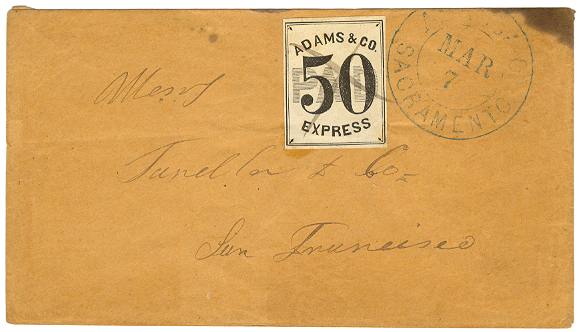|
The Adams & Co. Stamps |
|
|
|
|
|
Adams Express "Envelope"
Stamps
Adams & Co. 25 cents and 50 cents "envelope" stamps" are listed in Scott's catalog as shown in the illustration below from 2004 Specialized Catalog Of United States Stamps & Covers.
The 50c is reported on imprinted on unused 3c and 6c Nesbitt entires. I can locate no reference to the 25c existing on Nesbitt entire. The two "used" covers of the 50c are shown below and are from the Alfred Lichtenstein collection. Both have Philatelic Foundation certificates stating that "The Adams' stamp and the 50c imprint have been added to an otherwise genuine Bamber's Express cover."
Both of the above conjunctive express covers can be traced to the 1890's having been purchased from H.B. Phillips. Both examples have the 50c Adams impressed on a 3c Nesbitt entire. Both are combinations with the 25c adhesive Adam's stamp. It should be noted that the J. Bamber Contra Express oval handstamps appear under the adhesive stamps. According to Nathan's Franks Of The Western Expresses, J.W. Hoag, John Bamber and Charles Gable purchased interest in a Contra Cost Express in October, 1855. The express operations were not called "Bamber & Company Contra Costa Express" until 1858. These dates are both well past the demise of Adam's and Company which failed on February 23, 1855. A conjunctive express usage of those two companies is therefore impossible. So, what we have in these two examples are genuine usages by Contra Costa Express, circa 1858, to San Francisco. These genuine usages have been "enhanced" by the application of the 50c Adams imprint, the addition of a 25c Adams adhesive stamp, and both tied by fake postmarks. It should also be noted that the first cover bears a black "Adams Georgetown Nov 3" postmark and the second item a black "Adams Sacramento May 26" postmark. The above establishes the fact that the Adams imprints on these two covers was done after 1858. A notice that appeared in Collectors World, March 1879, Vo. 1, #7, page 51, by C.H. Coster noted:
Although the comments specifically regard the Adam's 25c stamp, I think they also hold true for the 50c types. The cancels on other fantasy products produced by Wuesthoff are often in a distinct orange red color. An example of this is shown below (the stamp used to illustrate the Scott's catalog) on a 25c Adams stamp as described by Coster except dated January 14. For a discussion of cancels found on Adam's stamps, see here.
Likewise, the 50c cut out illustrated in the Scott's catalog is taken from the cover shown below. It is not a cut out from an envelope as the paper is wove rather than laid. The manuscript cancel is not contemporary with the postmark. According to an internal Adams & Co. letter dated October 26, 1854 the first stamps were distributed on that date. These stamps were, I believe, intended to be used as a kind of scrip for small change. As Adam's & Company failed in February, 1855 there is no chance a cover dated March 7th bearing stamps can exist genuine. The Adams Sacramento marking on this cover is genuine and differs from the fake example shown above in that on the genuine strikes the letters are less thin than on the fake.
Wuesthof is reported by Coster to have sold several limited edition fantasy issues including Buffalo City Despatch Post and New Haven City Despatch. Many of his products bear the distinct orange red cancels that I have not seen on fakes other than those sold by Wuesthoff. I believe that the Adam's "envelope stamps" should be added to the list of fantasies. I believe that all of the envelope stamp listings should be removed from Scott catalog as I feel that they represent a fantasy produced in the 1870's and sold by a stamp dealer from New York named Wuesthof. |
Richard Frajola (July 12, 2004)



